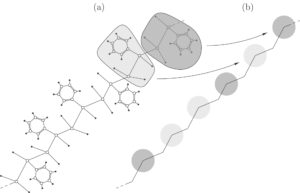Particle-based material description
Particle-based material description
Force fields as used in Molecular Dynamics simulations describe the potential energy of a molecular system, either in atomistic or coarse-grained resolution. Their functional form and parameters are identified in either physical or chemical experiments or quantum mechanical calculations. Therefore, they are able to accurately model the molecular structure of the described material and thus can be used to investigate effects on the molecular level.
From a computational point of view, the number of degrees of freedom to be handled in particle systems at atomistic resolution prohibits the computation of many complex materials. However, coarse graining allows for a significant reduction of the degrees of freedom in various particle applications with sufficient accuracy. This is achieved by subsuming a certain number of atoms into a so-called superatom (cf. Fig. 1).
As sample systems, we currently use a coarse-grained description for polystyrene [1] as well as a generic coarse-grained model [2], which is based on [3]. Recently, we have examined the effect of considering bond breakage in the interaction potentials [4,5].
–Dr.-Ing. Maximilian Ries and Felix Weber (M. Sc.)
 Fig. 1: Polystyrene chain in atomistic (a) and coarse-grained (b) resolution.
Fig. 1: Polystyrene chain in atomistic (a) and coarse-grained (b) resolution.
[1] H.-J. Qian, P. Carbone, X. Chen, H. A. Karimi-Varzaneh, C. C. Liew, F. Müller-Plathe, “Temperature-Transferable Coarse-Grained Potentials for Ethylbenzene, Polystyrene, and Their Mixtures”, Macromolecules, vol. 41, pp. 9919-9929, 2008
[2] M. Ries, J. Seibert, P. Steinmann, S. Pfaller, “Applying a generic and fast coarse-grained molecular dynamics model to extensively study the mechanical behavior of polymer nanocomposites”, eXPRESS Polymer Letters, vol. 16, pp. 1304-1321, 2022
[3] V. Bocharova, A.-C. Genix, J.-M. Y. Carrillo, R. Kumar, B. Carroll, A. Erwin, D. Voylov, A. Kisliuk, Y. Wang, B. G. Sumpter, A. P. Sokolov, Addition of Short Polymer Chains Mechanically Reinforces Glassy Poly(2-vinylpyridine)–Silica Nanoparticle Nanocomposites, ACS Applied Nano Materials vol.3(4), pp. 3427-3438, 2020
[4] W. Zhao, Y. Jain, F. Müller-Plathe, P. Steinmann, S. Pfaller, “Investigating fracture mechanisms in glassy polymers using coupled particle-continuum simulations”, Journal of the Mechanics and Physics of Solids, vol. 193, p. 105884, 2024
[5] F. Weber, V. Dötschel, P. Steinmann, S. Pfaller, M. Ries, “Evaluating the impact of filler size and filler content on the stiffness, strength, and toughness of polymer nanocomposites using coarse-grained molecular dynamics”, Engineering Fracture Mechanics, vol. 307, p. 110270, 2024
Milestones
- Adaptation of a generic coarse-grained model:
Ries, M.; Seibert, J.; Steinmann, P.; Pfaller, S.: Applying a generic and fast coarse-grained molecular dynamics model to extensively study the mechanical behavior of polymer nanocomposites. eXPRESS Polymer Letters, 16, 1304-1321 (2022). https://doi.org/10.3144/expresspolymlett.2022.94. - Integration of bond breakage:
i) Zhao, W.; Jain, Y.; Steinmann, P.; Pfaller, S.: Investigating fracture mechanisms in glassy polymers using coupled particle-continuum simulations. Journal of the Mechanics and Physics of Solids, 193, 105884 (2024). https://doi.org/10.1016/j.jmps.2024.105884.
ii) Weber, F.; Dötschel, V.; Steinmann, P.; Pfaller, S.; Ries, M.: Evaluating the impact of filler size and filler content on the stiffness, strength, and toughness of polymer nanocomposites using coarse-grained molecular dynamics. Engineering Fracture Mechanics, 307, 110270 (2024). https://doi.org/10.1016/j.engfracmech.2024.110270.
